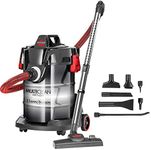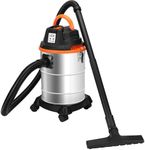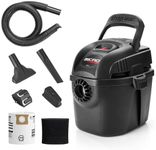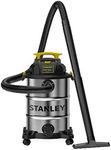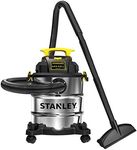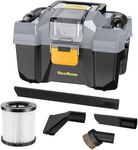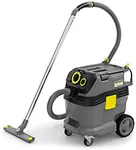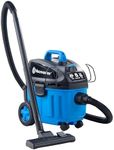Buying Guide for the Best Shop Vac Vacuums
Choosing the right shop-vac vacuum can make cleaning up your workshop, garage, or renovation site much easier and more efficient. Shop-vacs are designed to handle tougher messes than regular household vacuums, including sawdust, debris, and even liquids. To find the best fit for your needs, it's important to understand the key features and specifications that set different models apart. By considering how and where you'll use your shop-vac, you can focus on the specs that matter most for your situation.Tank CapacityTank capacity refers to how much debris or liquid the shop-vac can hold before it needs to be emptied. This is important because a larger tank means you can clean for longer without stopping, but it also makes the vacuum heavier and bulkier. Small tanks (2-6 gallons) are great for quick cleanups or small spaces, medium tanks (7-12 gallons) suit most home workshops, and large tanks (14 gallons or more) are best for big jobs or commercial use. Think about the size of your typical messes and how much storage space you have to decide what tank size is right for you.
Horsepower (HP) or Motor PowerHorsepower or motor power tells you how strong the vacuum's suction is. More power means the vacuum can pick up heavier debris and handle tougher jobs. Lower power (1-2 HP) is fine for light dust and small debris, medium power (3-4 HP) works well for most home projects, and higher power (5 HP or more) is best for heavy-duty or commercial tasks. If you mostly clean up fine dust or small messes, you don't need the highest power, but for larger debris or wet messes, more power is helpful.
Wet/Dry CapabilityWet/dry capability means the shop-vac can handle both dry debris and liquid spills. This is a key feature that sets shop-vacs apart from regular vacuums. Some models are only for dry use, while most can handle both. If you expect to clean up water, spills, or wet messes, make sure to choose a wet/dry model. If you'll only be vacuuming dry materials, you might not need this feature.
Portability and WeightPortability and weight affect how easy it is to move the shop-vac around your workspace or carry it up and down stairs. Lighter, more compact models are easier to move and store, but may have smaller tanks and less power. Heavier models can handle bigger jobs but may be harder to transport. Consider how often you'll need to move the vacuum and how much space you have for storage when deciding on the right balance for you.
Filtration SystemThe filtration system determines how well the shop-vac traps dust and prevents it from blowing back into the air. Basic filters are fine for large debris, but if you deal with fine dust, allergens, or hazardous materials, look for models with HEPA or high-efficiency filters. Some filters are washable and reusable, while others need to be replaced. Think about the type of messes you clean up and whether air quality is a concern in your workspace.
Hose Length and AttachmentsHose length and attachments affect how easily you can reach different areas and clean various surfaces. Longer hoses let you reach further without moving the vacuum, but can be harder to store. Attachments like crevice tools, brushes, and extension wands make it easier to clean tight spaces, upholstery, or car interiors. Consider what you'll be cleaning and whether you need special attachments or extra reach.


